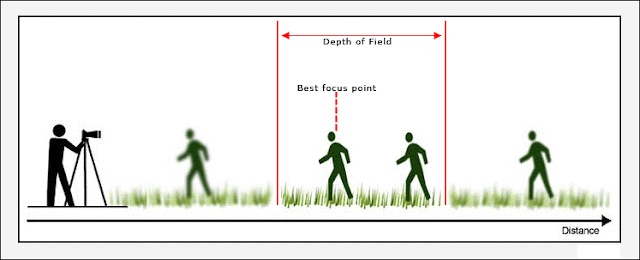May 31, 2011
Understanding Depth of Field
Depth of Field object associated with how sharp the photos we take. it depends on how big the opening of the lens used in the shooting. so that each photo has a matte finish that is different. In this discussion will present some things about the lens aperture and Depth of Field itself. To understand the Depth of Field, it would be better if we first understand the lens aperture.
There are several lens aperture size is generally found in the lens were:
few stops.
After understanding some of the type and size of the aperture lens, this course will also make it easier to understand about themselves and the Depth of Field will be very helpful when trying to determine how thick the desired Depth of Field when creating a photograph. In this case I Depth of Field categorize it into three types and usefulness. Namely, among others :
Using a thin Depth of Field is perfect to make the main object of focus is much more visible. In addition, thin Depth of Field is very good if you want to avoid interference from the background and the results background will be a blur.
At the photo shoot with a thin Depth of Field suitable for photographing the type of macro photos, photo portrait, close-up photographs, photographs of models and can also be used to photograph candid.
Depth of Field like this is suitable for making photos look like the main object is not so "alone". it's good to give the impression of where the image objects that are not so clear / clear or describe objects in public places such as giving the impression in the yard, in parks, indoor or another.
Use this Depth of Field usually very suitable for panoramic photo or a landscape, scenery and the like.
 |
| Diaphragms of Lens |
Aperture in Lens
Any lens used on the camera has a level or size of each and produce different images. Aperture lenses generally have a size by using the symbol f with numbering. In addition to the lens aperture affects the Depth of Field of a photograph, it also affects the size of the incoming light. |
| Depth of Field |
There are several lens aperture size is generally found in the lens were:
 |
| Aperture in Lens |
1. Large Aperture (f/1.2, f/1.4, f/1.8, f/2.8, f/3.5)
Large aperture gives advantages in lower light or when shooting a little because even though the intensity of light is very minimal but it could provide for the lens to produce a photograph that was enough light.2. Medium Aperture (f / 4, f/5.6, f/6.2, f/7.1)
Intermediate lens aperture provides enough light enters the camera when the light intensity is not too dark. Most of the standard and telephoto lenses generally have a medium-size aperture.3. Small Aperture (f / 8, f/10, f/11, f/16, f/20, f/22, f/24, f/30)
Small aperture resulted in the intensity of light entering into the camera less than the large and medium-sized openings. Aperture lens like this will affect the camera shutter speed to be down afew stops.
After understanding some of the type and size of the aperture lens, this course will also make it easier to understand about themselves and the Depth of Field will be very helpful when trying to determine how thick the desired Depth of Field when creating a photograph. In this case I Depth of Field categorize it into three types and usefulness. Namely, among others :
1. Thin
Thin Depth of Field resulting from using a large aperture lens, the distance between the main object and the background distance away and taking pictures of distant objects (using a telephoto lens with a maximum zooming) and by using macro mode.Using a thin Depth of Field is perfect to make the main object of focus is much more visible. In addition, thin Depth of Field is very good if you want to avoid interference from the background and the results background will be a blur.
At the photo shoot with a thin Depth of Field suitable for photographing the type of macro photos, photo portrait, close-up photographs, photographs of models and can also be used to photograph candid.
2. Medium
This Depth of Field are generated from intermediate lens aperture, the foreground and background is not too far away.Depth of Field like this is suitable for making photos look like the main object is not so "alone". it's good to give the impression of where the image objects that are not so clear / clear or describe objects in public places such as giving the impression in the yard, in parks, indoor or another.
3. Thickness
This Depth of Field produced from a small lens aperture and / or wide lenses. This Depth of Field type is intended for all of the existing objects in the foreground or background details clearly visible and not produce the impression of motion blur.Use this Depth of Field usually very suitable for panoramic photo or a landscape, scenery and the like.
Subscribe to:
Post Comments (Atom)




No comments:
Post a Comment